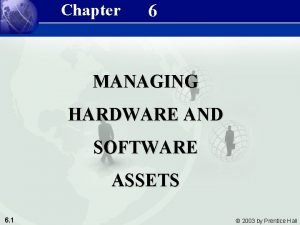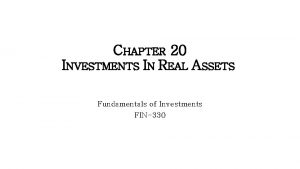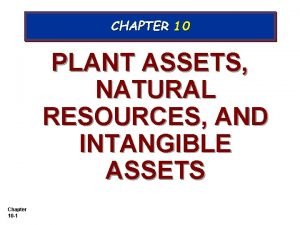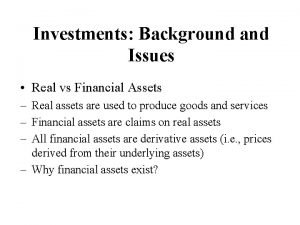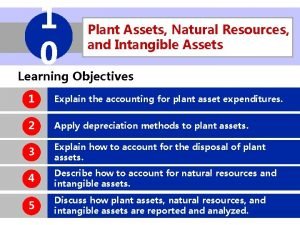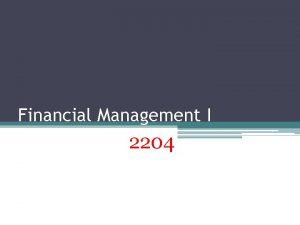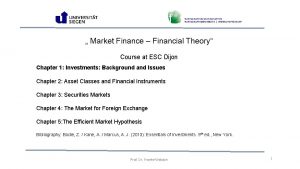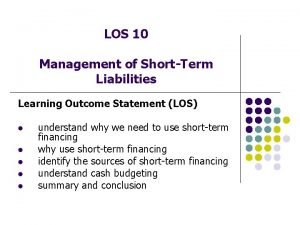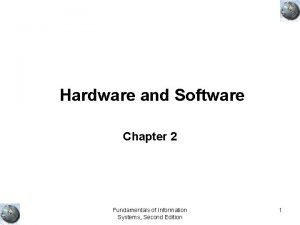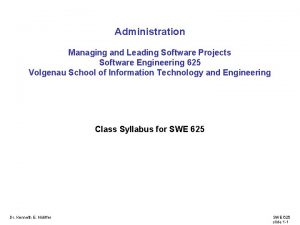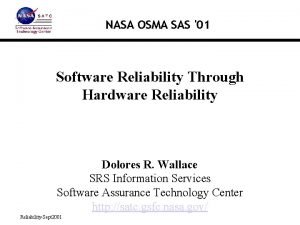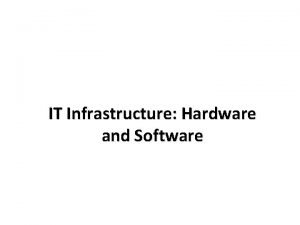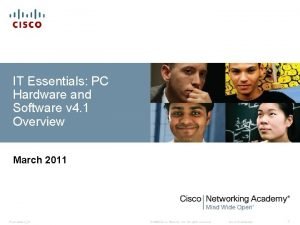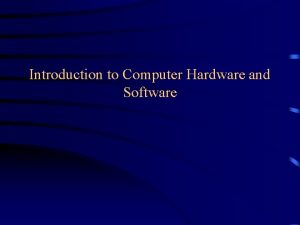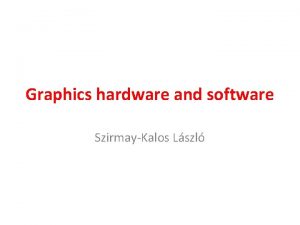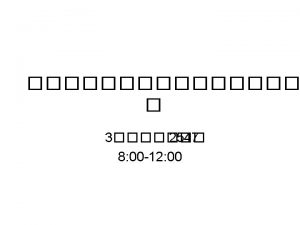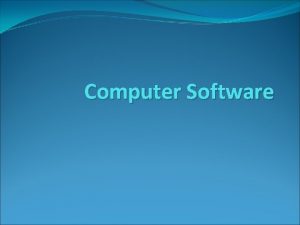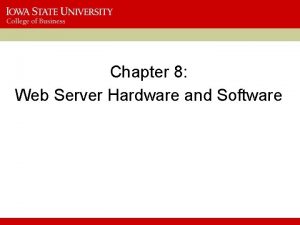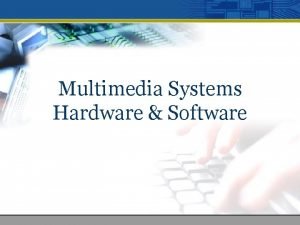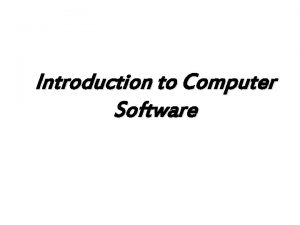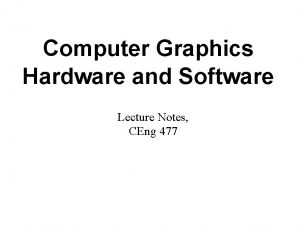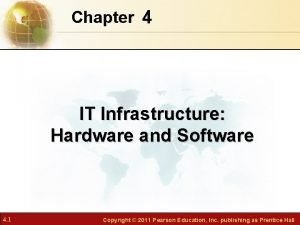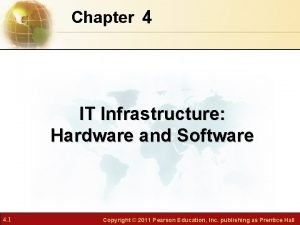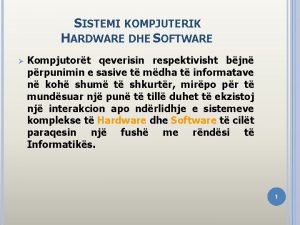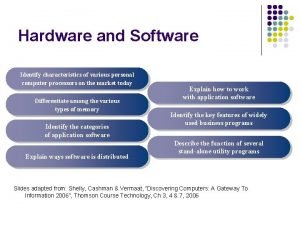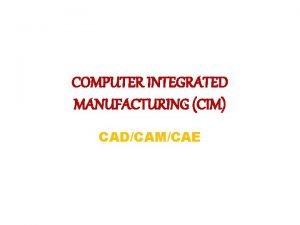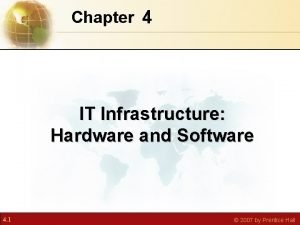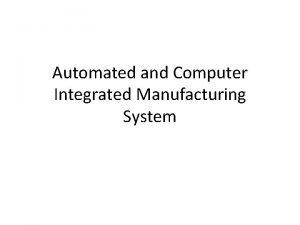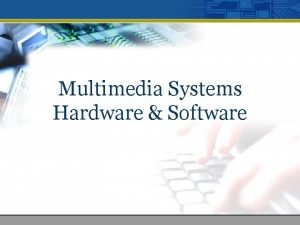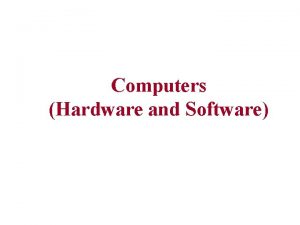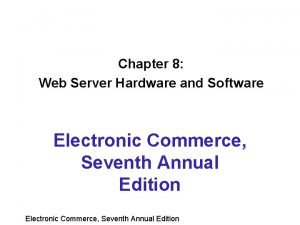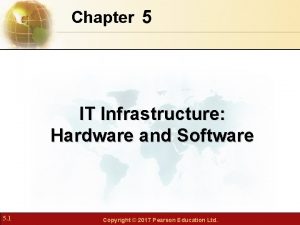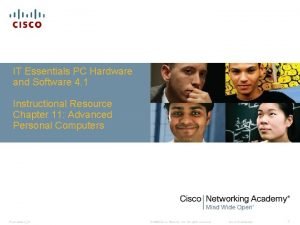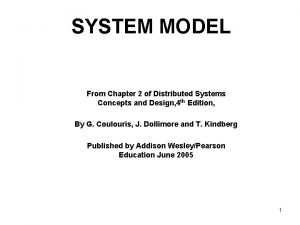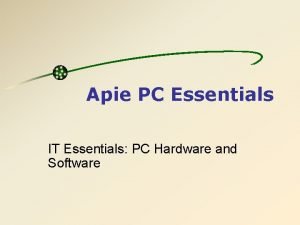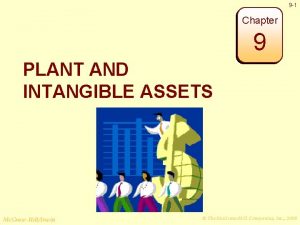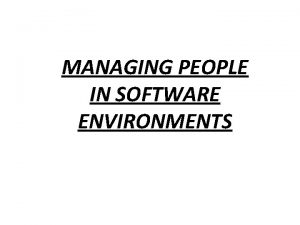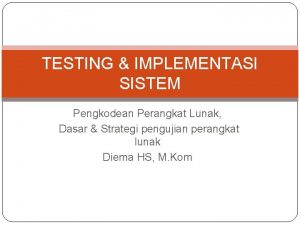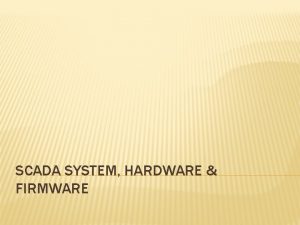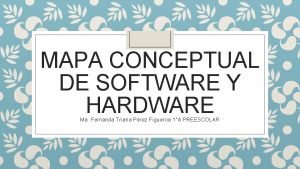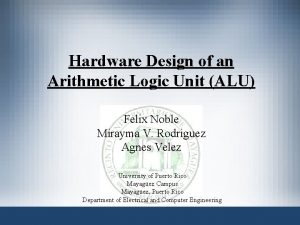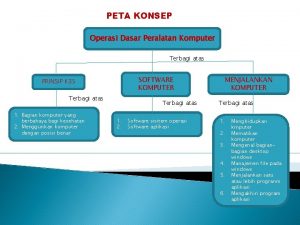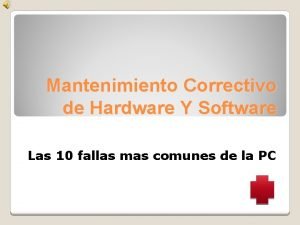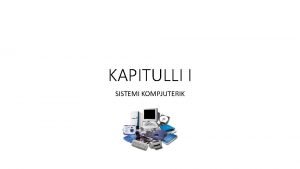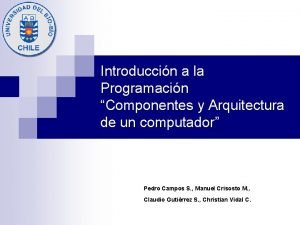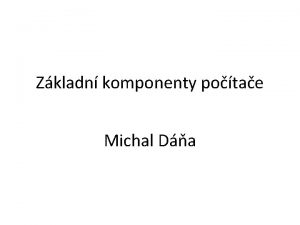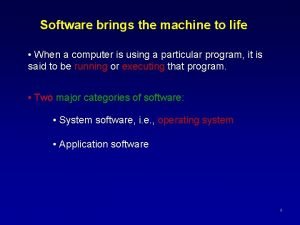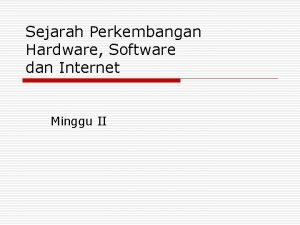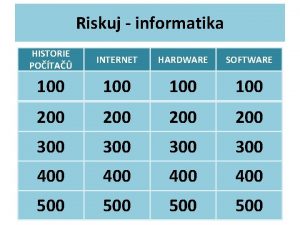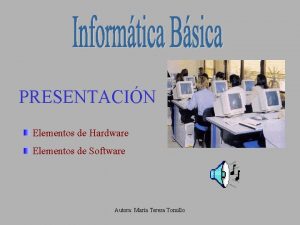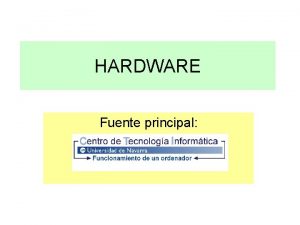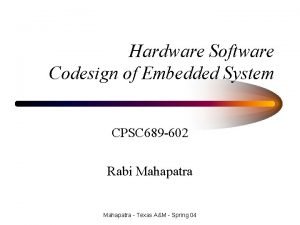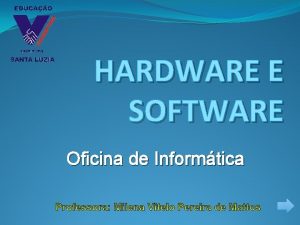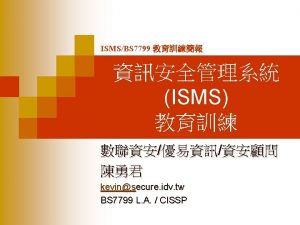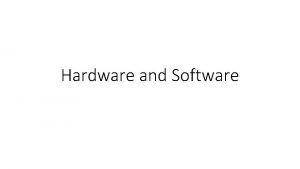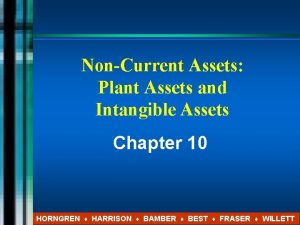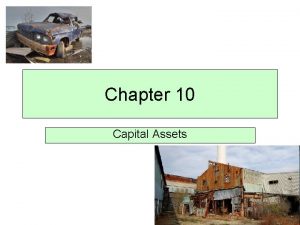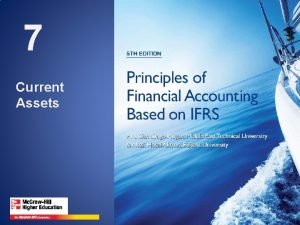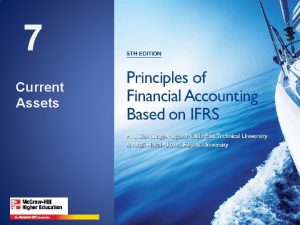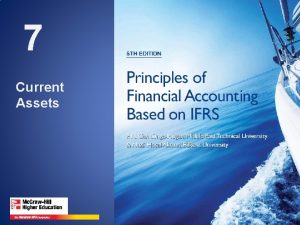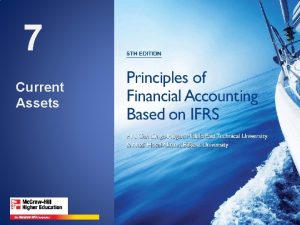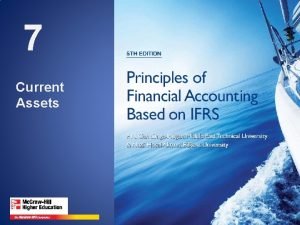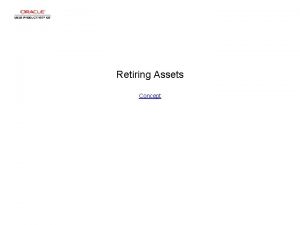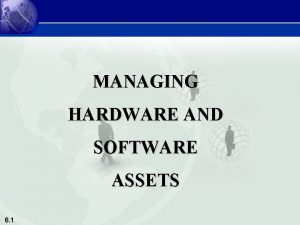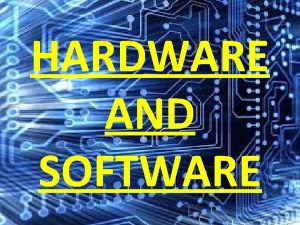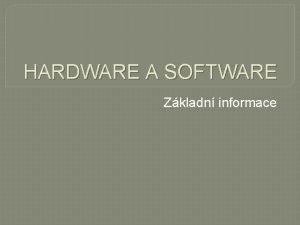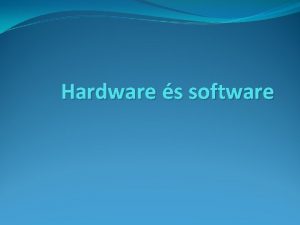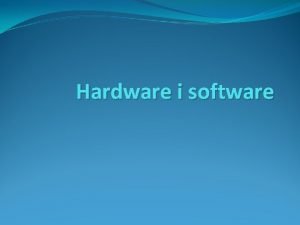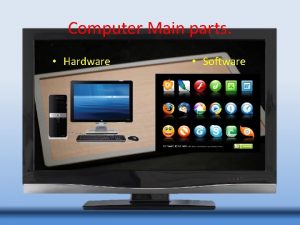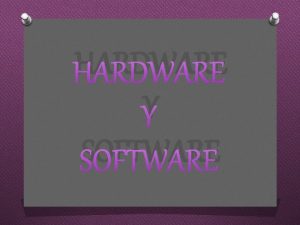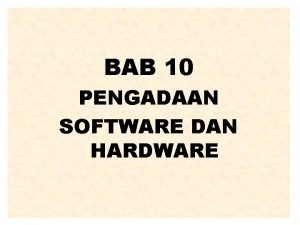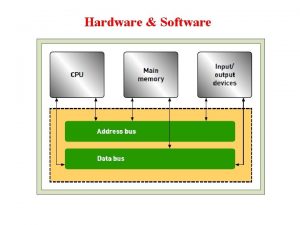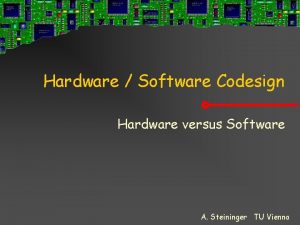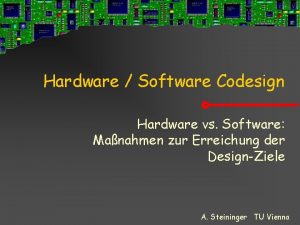Chapter 6 MANAGING HARDWARE AND SOFTWARE ASSETS 6































































- Slides: 63

Chapter 6 MANAGING HARDWARE AND SOFTWARE ASSETS 6. 1 © 2003 by Prentice Hall

Essentials of Management Information Systems Chapter 6 Managing Hardware and Software Assets OBJECTIVES • What computer processing and storage capability does our organization need to handle its information and business transactions? • What arrangement of computers and computer processing would best benefit our organization? 6. 2 • What kinds of software and software tools do we need to run our business? What criteria should we use to select our software technology? © 2003 by Prentice Hall

Essentials of Management Information Systems Chapter 6 Managing Hardware and Software Assets OBJECTIVES • Of what new software technologies should we be aware? How would they benefit our organization? • How should we acquire and manage the firm’s hardware and software assets? 6. 3 © 2003 by Prentice Hall

Essentials of Management Information Systems Chapter 6 Managing Hardware and Software Assets MANAGEMENT CHALLENGES 6. 4 • The centralization versus decentralization debate • The application backlog © 2003 by Prentice Hall

Essentials of Management Information Systems Chapter 6 Managing Hardware and Software Assets COMPUTER HARDWARE AND INFORMATION TECHNOLOGY INFRASTRUCTURE Hardware Components of a Computer System Figure 6 -1 6. 5 © 2003 by Prentice Hall

Essentials of Management Information Systems Chapter 6 Managing Hardware and Software Assets COMPUTER HARDWARE AND INFORMATION TECHNOLOGY INFRASTRUCTURE The Computer System bit • Binary digit • Represents smallest unit of data in the form of either 0 or 1 byte 6. 6 • String of bits, usually eight • Stores one number or character © 2003 by Prentice Hall

Essentials of Management Information Systems Chapter 6 Managing Hardware and Software Assets COMPUTER HARDWARE AND INFORMATION TECHNOLOGY INFRASTRUCTURE Bits and Bytes 6. 7 Figure 6 -2 © 2003 by Prentice Hall

Essentials of Management Information Systems Chapter 6 Managing Hardware and Software Assets COMPUTER HARDWARE AND INFORMATION TECHNOLOGY INFRASTRUCTURE The CPU and Primary Storage Central Processing Unit (CPU) 6. 8 • Manipulates symbols, numbers, and letters • Controls other parts of the computer system © 2003 by Prentice Hall

Essentials of Management Information Systems Chapter 6 Managing Hardware and Software Assets COMPUTER HARDWARE AND INFORMATION TECHNOLOGY INFRASTRUCTURE The CPU and Primary Storage 6. 9 • Temporarily stores program instructions • Data being used by the instructions © 2003 by Prentice Hall

Essentials of Management Information Systems Chapter 6 Managing Hardware and Software Assets COMPUTER HARDWARE AND INFORMATION TECHNOLOGY INFRASTRUCTURE The CPU and Primary Storage 6. 10 Figure 6 -3 © 2003 by Prentice Hall

Essentials of Management Information Systems Chapter 6 Managing Hardware and Software Assets COMPUTER HARDWARE AND INFORMATION TECHNOLOGY INFRASTRUCTURE Primary Storage Stores 6. 11 • Software program being executed • Operating system programs • Data being used by program © 2003 by Prentice Hall

Essentials of Management Information Systems Chapter 6 Managing Hardware and Software Assets COMPUTER HARDWARE AND INFORMATION TECHNOLOGY INFRASTRUCTURE Primary Storage 6. 12 • Arithmetic-logic unit (ALU): performs the computer’s principal logic and arithmetic operations • Control Unit: coordinates and controls the other parts of the computer system © 2003 by Prentice Hall

Essentials of Management Information Systems Chapter 6 Managing Hardware and Software Assets COMPUTER HARDWARE AND INFORMATION TECHNOLOGY INFRASTRUCTURE Primary Storage 6. 13 • RAM: Directly accesses any randomly chosen location in the same amount of time • ROM: Semiconductor memory chips with program instructions, cannot be written to © 2003 by Prentice Hall

Essentials of Management Information Systems Chapter 6 Managing Hardware and Software Assets COMPUTER HARDWARE AND INFORMATION TECHNOLOGY INFRASTRUCTURE Computer Processing Microprocessors and Processing Power 6. 14 • Integrated circuit technology • Integrates the computer’s memory, logic, and control on a single chip © 2003 by Prentice Hall

Essentials of Management Information Systems Chapter 6 Managing Hardware and Software Assets COMPUTER HARDWARE AND INFORMATION TECHNOLOGY INFRASTRUCTURE Computer Processing Parallel Processing 6. 15 • Problem broken down into smaller parts • Multiple instructions processed simultaneously with multiple processors © 2003 by Prentice Hall

Essentials of Management Information Systems Chapter 6 Managing Hardware and Software Assets COMPUTER HARDWARE AND INFORMATION TECHNOLOGY INFRASTRUCTURE Sequential and Parallel Processing 6. 16 Figure 6 -4 © 2003 by Prentice Hall

Essentials of Management Information Systems Chapter 6 Managing Hardware and Software Assets STORAGE, INPUT AND OUTPUT TECHNOLOGY Secondary Storage Technology 6. 17 • Magnetic disk: Floppy disk, Hard disk • Optical disks: CD-ROM, DVDs • Magnetic tape: Inexpensive, older • New storage alternatives: Storage secondary-storage medium Area Networks (SANs) © 2003 by Prentice Hall

Essentials of Management Information Systems Chapter 6 Managing Hardware and Software Assets STORAGE, INPUT AND OUTPUT TECHNOLOGY A Storage Area Network (SAN) 6. 18 Figure 6 -5 © 2003 by Prentice Hall

Essentials of Management Information Systems Chapter 6 Managing Hardware and Software Assets STORAGE, INPUT AND OUTPUT TECHNOLOGY Input and Output Devices 6. 19 © 2003 by Prentice Hall

Essentials of Management Information Systems Chapter 6 Managing Hardware and Software Assets STORAGE, INPUT AND OUTPUT TECHNOLOGY Input and Output Devices 6. 20 © 2003 by Prentice Hall

Essentials of Management Information Systems Chapter 6 Managing Hardware and Software Assets STORAGE, INPUT AND OUTPUT TECHNOLOGY Batch and On-Line Input and Processing Batch processing • Transactions accumulated and stored until processing On-line processing • 6. 21 Transactions are entered directly into computer and processed immediately © 2003 by Prentice Hall

Essentials of Management Information Systems Chapter 6 Managing Hardware and Software Assets STORAGE, INPUT AND OUTPUT TECHNOLOGY A Comparison of Batch and On-line Processing 6. 22 Figure 6 -6 © 2003 by Prentice Hall

Essentials of Management Information Systems Chapter 6 Managing Hardware and Software Assets STORAGE, INPUT AND OUTPUT TECHNOLOGY Interactive Multimedia • 6. 23 Integrates two or more types of media into a computer-based application © 2003 by Prentice Hall

Essentials of Management Information Systems Chapter 6 Managing Hardware and Software Assets CATEGORIES OF COMPUTERS AND COMPUTER SYSTEMS Classifying Computers 6. 24 • Mainframes: Largest computer, massive • Midrange computers: Less powerful, • Server: Provides software and other memory, rapid processing power less expensive, and smaller than a mainframe resources to computers over a network © 2003 by Prentice Hall

Essentials of Management Information Systems Chapter 6 Managing Hardware and Software Assets CATEGORIES OF COMPUTERS AND COMPUTER SYSTEMS Classifying Computers 6. 25 • Minicomputers: Middle-range computer, • Server Farm: Large group of servers used in universities, factories, or research laboratories maintained by a commercial vendor, available for electronic commerce and other activities © 2003 by Prentice Hall

Essentials of Management Information Systems Chapter 6 Managing Hardware and Software Assets CATEGORIES OF COMPUTERS AND COMPUTER SYSTEMS Classifying Computers 6. 26 • Personal Computer (PC): Small desktop • Workstation: Desktop computer with • Supercomputer: Highly sophisticated or portable computer powerful graphics and mathematical capabilities and powerful, performs complex computations © 2003 by Prentice Hall

Essentials of Management Information Systems Chapter 6 Managing Hardware and Software Assets CATEGORIES OF COMPUTERS AND COMPUTER SYSTEMS Computer Networks and Client/Server Computing • Distributed processing: Distribution of processing work among multiple computers • Centralized processing: Accomplished by one large central computer • Client/server computing: Splits processing between “clients” and “servers” on network 6. 27 © 2003 by Prentice Hall

Essentials of Management Information Systems Chapter 6 Managing Hardware and Software Assets CATEGORIES OF COMPUTERS AND COMPUTER SYSTEMS Client/Server Computing 6. 28 Figure 6 -7 © 2003 by Prentice Hall

Essentials of Management Information Systems Chapter 6 Managing Hardware and Software Assets CATEGORIES OF COMPUTERS AND COMPUTER SYSTEMS Types of Client/Server Computing Figure 6 -8 6. 29 © 2003 by Prentice Hall

Essentials of Management Information Systems Chapter 6 Managing Hardware and Software Assets CATEGORIES OF COMPUTERS AND COMPUTER SYSTEMS Network Computers and Peer-to-Peer Computing • Network computer (NC): Simplified desktop computer, does not store data permanently • Peer-to-peer computing: Distributed processing that links computers through Internet or private networks 6. 30 © 2003 by Prentice Hall

Essentials of Management Information Systems Chapter 6 Managing Hardware and Software Assets TYPES OF SOFTWARE • Software program: Series of statements or instructions to the computer • System software: Generalized programs, manages computer’s resources • Application software: Programs written to perform functions specified by end users 6. 31 © 2003 by Prentice Hall

Essentials of Management Information Systems Chapter 6 Managing Hardware and Software Assets TYPES OF SOFTWARE The Major Types of Software 6. 32 Figure 6 -9 © 2003 by Prentice Hall

Essentials of Management Information Systems Chapter 6 Managing Hardware and Software Assets TYPES OF SOFTWARE System Software and PC Operating Systems Operating system • System software • Manages and controls computer 6. 33 © 2003 by Prentice Hall

Essentials of Management Information Systems Chapter 6 Managing Hardware and Software Assets TYPES OF SOFTWARE System Software and PC Operating Systems Functions of the operating system • Allocates and assigns system resources • Schedules use of computer resources • Monitors computer system activities • Provides locations in primary memory for data and programs • Controls the input and output devices 6. 34 © 2003 by Prentice Hall

Essentials of Management Information Systems Chapter 6 Managing Hardware and Software Assets TYPES OF SOFTWARE System Software and PC Operating Systems Multiprogramming • Executes two or more programs concurrently using the same computer • CPU executes only one program but services the input/output needs of others 6. 35 © 2003 by Prentice Hall

Essentials of Management Information Systems Chapter 6 Managing Hardware and Software Assets TYPES OF SOFTWARE Single-Program Execution Versus Multiprogramming Figure 6 -10 6. 36 © 2003 by Prentice Hall

Essentials of Management Information Systems Chapter 6 Managing Hardware and Software Assets TYPES OF SOFTWARE System Software and PC Operating Systems Multitasking • Multiprogramming capability of singleuser operating systems Virtual Storage • Handles programs more efficiently by dividing the programs into small fixed or variable length 6. 37 © 2003 by Prentice Hall

Essentials of Management Information Systems Chapter 6 Managing Hardware and Software Assets TYPES OF SOFTWARE Virtual Storage Figure 6 -11 6. 38 © 2003 by Prentice Hall

Essentials of Management Information Systems Chapter 6 Managing Hardware and Software Assets TYPES OF SOFTWARE System Software and PC Operating Systems Time Sharing • Sharing of computer resources by many users simultaneously Multiprocessing • Executing two or more instructions simultaneously in a single computer using multiple central processing units 6. 39 © 2003 by Prentice Hall

Essentials of Management Information Systems Chapter 6 Managing Hardware and Software Assets TYPES OF SOFTWARE System Software and PC Operating Systems Language translation and utility software • Translates high-level language programs into machine language 6. 40 © 2003 by Prentice Hall

Essentials of Management Information Systems Chapter 6 Managing Hardware and Software Assets TYPES OF SOFTWARE PC Operating Systems and Graphical User Interfaces • GUI • Microsoft’s Windows 98 • Windows Millennium Edition (Windows Me) • Windows 2000 6. 41 © 2003 by Prentice Hall

Essentials of Management Information Systems Chapter 6 Managing Hardware and Software Assets TYPES OF SOFTWARE PC Operating Systems and Graphical User Interfaces • Windows XP • UNIX • Linux 6. 42 © 2003 by Prentice Hall

Essentials of Management Information Systems Chapter 6 Managing Hardware and Software Assets TYPES OF SOFTWARE Application Software and Programming Languages • Programming languages: Consists of 1 s and 0 s of binary code • Assembly language: Resembles machine language, substitutes mnemonics for numeric codes • Third-generation languages: FORTRAN, COBOL, BASIC, Pascal, and C 6. 43 © 2003 by Prentice Hall

Essentials of Management Information Systems Chapter 6 Managing Hardware and Software Assets TYPES OF SOFTWARE Assembly language Figure 6 -12 6. 44 © 2003 by Prentice Hall

Essentials of Management Information Systems Chapter 6 Managing Hardware and Software Assets TYPES OF SOFTWARE FORTRAN Figure 6 -13 6. 45 © 2003 by Prentice Hall

Essentials of Management Information Systems Chapter 6 Managing Hardware and Software Assets TYPES OF SOFTWARE COBOL Figure 6 -14 6. 46 © 2003 by Prentice Hall

Essentials of Management Information Systems Chapter 6 Managing Hardware and Software Assets TYPES OF SOFTWARE Fourth-Generation Languages and PC Software Tools • Fourth-generation language: Employed directly by end users • Natural languages: Close to human language 6. 47 © 2003 by Prentice Hall

Essentials of Management Information Systems Chapter 6 Managing Hardware and Software Assets TYPES OF SOFTWARE Fourth-Generation Languages and PC Software Tools • Query languages: Provides immediate on-line answers to requests • Application software packages and PC software tools: Word Processing Software, Spreadsheets, Data Management Software 6. 48 © 2003 by Prentice Hall

Essentials of Management Information Systems Chapter 6 Managing Hardware and Software Assets TYPES OF SOFTWARE Spreadsheet Software 6. 49 Figure 6 -16 © 2003 by Prentice Hall

Essentials of Management Information Systems Chapter 6 Managing Hardware and Software Assets TYPES OF SOFTWARE Data Management Software 6. 50 Figure 6 -17 © 2003 by Prentice Hall

Essentials of Management Information Systems Chapter 6 Managing Hardware and Software Assets TYPES OF SOFTWARE Software for Enterprise Integration: Enterprise Software and Middleware Enterprise software • Set of integrated modules • Allows data to be used by multiple functions and business processes 6. 51 © 2003 by Prentice Hall

Essentials of Management Information Systems Chapter 6 Managing Hardware and Software Assets TYPES OF SOFTWARE Software for Enterprise Integration: Enterprise Software and Middleware • Allows two disparate applications to communicate to exchange data Web server • Manages requests for Web pages on the computer where they are stored 6. 52 © 2003 by Prentice Hall

Essentials of Management Information Systems Chapter 6 Managing Hardware and Software Assets TYPES OF SOFTWARE Middleware Figure 6 -18 6. 53 © 2003 by Prentice Hall

Essentials of Management Information Systems Chapter 6 Managing Hardware and Software Assets TYPES OF SOFTWARE Software for Enterprise Integration: Enterprise Software and Middleware Enterprise application integration software • Ties together multiple applications to support enterprise integration 6. 54 © 2003 by Prentice Hall

Essentials of Management Information Systems Chapter 6 Managing Hardware and Software Assets CONTEMPORARY TOOLS FOR SOFTWARE DEVELOPMENT Object-Oriented Programming Object-oriented programming • Approach to software development that combines data and procedures into a single object Visual programming • Construction of software programs by selecting and arranging programming objects 6. 55 © 2003 by Prentice Hall

Essentials of Management Information Systems Chapter 6 Managing Hardware and Software Assets CONTEMPORARY TOOLS FOR SOFTWARE DEVELOPMENT Class, subclasses, and overriding 6. 56 Figure 6 -19 © 2003 by Prentice Hall

Essentials of Management Information Systems Chapter 6 Managing Hardware and Software Assets CONTEMPORARY TOOLS FOR SOFTWARE DEVELOPMENT Java • Programming language • Delivers the software functionality needed for a particular task • Runs on any computer and operating system 6. 57 © 2003 by Prentice Hall

Essentials of Management Information Systems Chapter 6 Managing Hardware and Software Assets CONTEMPORARY TOOLS FOR SOFTWARE DEVELOPMENT Hypertext Markup Language (HTML) and XML • Hypertext Markup Language (HTML): Page description language, creates Web pages and other hypermedia documents • XML (e. Xtensible Markup Language): General-purpose language, supports links to multiple documents, used for both Web and non-Web applications 6. 58 © 2003 by Prentice Hall

Essentials of Management Information Systems Chapter 6 Managing Hardware and Software Assets HARDWARE TECHNOLOGY REQUIREMENTS Hardware Technology Requirements for Electronic Commerce and Digital Firm • Capacity planning: Process of predicting the computing power • Scalability: Ability of a computer, product, or system to expand to serve without breaking down 6. 59 © 2003 by Prentice Hall

Essentials of Management Information Systems Chapter 6 Managing Hardware and Software Assets HARDWARE TECHNOLOGY REQUIREMENTS Total Cost of Ownership (TCO) of Technology Assets • Designates the total cost of owning technology resources • Includes initial purchase costs, cost of hardware and software upgrades, maintenance, technical support, and training 6. 60 © 2003 by Prentice Hall

Essentials of Management Information Systems Chapter 6 Managing Hardware and Software Assets HARDWARE TECHNOLOGY REQUIREMENTS Rent or Build Decisions: Using Technology Service Providers On-Line storage service providers • Third-party provider • Rent out storage space to subscribers over the Web • Allow customers to store and access data 6. 61 © 2003 by Prentice Hall

Essentials of Management Information Systems Chapter 6 Managing Hardware and Software Assets HARDWARE TECHNOLOGY REQUIREMENTS Rent or Build Decisions: Using Technology Service Providers Application Service Providers (ASPs) • Provide software that can be rented by other companies Other Types of Service Providers • Provide additional resources for helping organizations manage their technology assets 6. 62 © 2003 by Prentice Hall

Chapter 6 MANAGING HARDWARE AND SOFTWARE ASSETS 6. 63 © 2003 by Prentice Hall
 Managing hardware and software assets
Managing hardware and software assets Plant assets natural resources and intangible assets
Plant assets natural resources and intangible assets Real assets and financial assets ppt
Real assets and financial assets ppt Accumulated depreciation straight line method
Accumulated depreciation straight line method Real assets versus financial assets
Real assets versus financial assets Plant assets, natural resources, and intangible assets
Plant assets, natural resources, and intangible assets Real assets vs financial assets
Real assets vs financial assets Financial assets examples
Financial assets examples Liquidity planning and managing cash assets
Liquidity planning and managing cash assets Managing short term assets and liabilities
Managing short term assets and liabilities Managing assets vs asset management
Managing assets vs asset management Managing assets vs asset management
Managing assets vs asset management Internal and external components of computer
Internal and external components of computer Chapter 2 hardware and software
Chapter 2 hardware and software Managing and leading software projects
Managing and leading software projects Osma sas
Osma sas Software and its types
Software and its types Cisco it essentials virtual desktop download free
Cisco it essentials virtual desktop download free Definition of software and hardware
Definition of software and hardware Vbo1
Vbo1 What is peopleware
What is peopleware Interface between application software
Interface between application software Web server hardware and software
Web server hardware and software Importance of hardware and software
Importance of hardware and software Persyaratan spesifikasi perangkat
Persyaratan spesifikasi perangkat Define multimedia hardware
Define multimedia hardware Machine having both hardware and software
Machine having both hardware and software Hardware and software in computer graphics
Hardware and software in computer graphics Hardware and software infrastructure
Hardware and software infrastructure Hardware and software infrastructure
Hardware and software infrastructure Hardware and software shqip
Hardware and software shqip Characteristics of hardware and software
Characteristics of hardware and software Components of cim
Components of cim It infrastructure hardware and software
It infrastructure hardware and software Cim wheel diagram
Cim wheel diagram Multimedia hardware and software
Multimedia hardware and software A computer system consists of both hardware and software.
A computer system consists of both hardware and software. Web server hardware and software
Web server hardware and software It infrastructure hardware and software
It infrastructure hardware and software It essentials pc hardware and software
It essentials pc hardware and software E commerce hardware
E commerce hardware Interaction model in distributed system
Interaction model in distributed system It essentials pc hardware and software
It essentials pc hardware and software Plant and intangible assets chapter 9
Plant and intangible assets chapter 9 Plant and intangible assets chapter 9
Plant and intangible assets chapter 9 Managing people in software engineering
Managing people in software engineering Auto coding software
Auto coding software Scada is a software or hardware
Scada is a software or hardware Mapa conceptual de hardware y software
Mapa conceptual de hardware y software Perangkat lunak jaringan komputer
Perangkat lunak jaringan komputer Alu hardware
Alu hardware Peta konsep komponen komputer
Peta konsep komponen komputer Mantenimiento correctivo hardware y software
Mantenimiento correctivo hardware y software Pjeset harduerike
Pjeset harduerike Mapa mental de software y hardware
Mapa mental de software y hardware Hardware x software
Hardware x software Hardware y software 1 eso
Hardware y software 1 eso Software brings computer hardware to life
Software brings computer hardware to life Perkembangan hardware dan software saat ini
Perkembangan hardware dan software saat ini Historie hardware
Historie hardware Hardware y software 1 eso
Hardware y software 1 eso Tipos de arquitectura de hardware
Tipos de arquitectura de hardware Hardware software codesign in embedded systems
Hardware software codesign in embedded systems Hardware de oficina
Hardware de oficina
